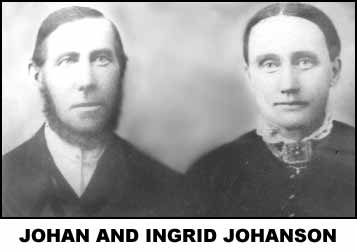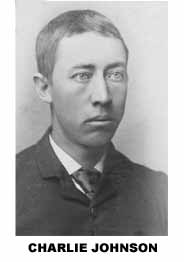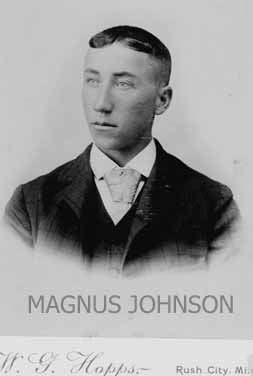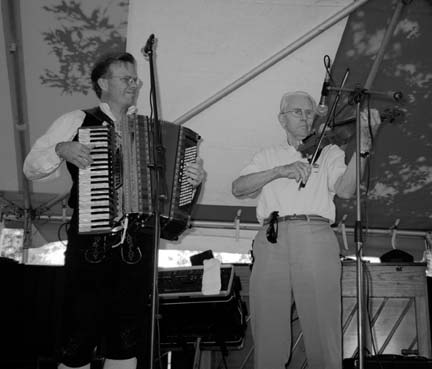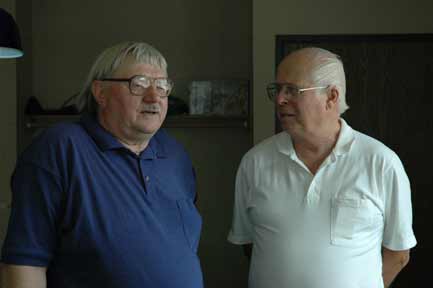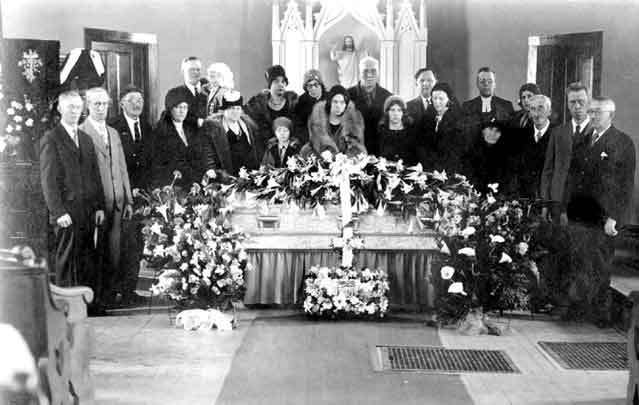| 8.
THIRD GENERATION (JOHNSON):
Johan Johansson (Sept. 6, 1836-Oct. 22, 1923) = (8.1)
Ingrid Magnusdotter (June 8, 1835-June 14, 1910) in
1860 The earliest settlers in the Harris area included Griggs, Herring and Day (location #1, Harris, 1888). Some of these settlers were civil war veterans. Griggs ran a sawmill and many of the first settlers built their houses and barns with lumber floated down Goose Creek. The Herrings arrived in 1868. None of the land farmed by our ancestors was obtained through The Homestead Act of 1862. Instead, lumber companies had bought non-connected forties and lumbered out the land in between, hauling the wood onto their own forties. They, along with land speculators, then sold the land to settlers. There were still a number of Indians in the neighborhood and several showed up one day at the Herring farm with the intention of killing Mr. Herring over some matter or other. He was not home, so Mrs. Herring stuffed them with pancakes until their sagging bellies quelled their impulse for revenge. Mr. Herring arrived ½ hour after the Indians left. Indians admired bravery and were impressed when a terrified woman, home alone, had the aplomb to cook up some food. Mrs. Herring's ploy of diverting Indians with food is typical of memoirs I've read by white women of that period (see Old Rail Fence Corners: Frontier Tales Told by Minnesota Pioneers, edited by Lucy Leavenworth Wilder Morris. Minnesota Historical Society, 1914, 1976). By the 1850's Indian tribes who lived east of or along the Mississippi had been displaced, most of them to reservations further west, by white settlement. Big game had been hunted out along with the beaver, otter and muskrat that fueled the fur trade. Their traditional culture disrupted, some Indians were wandering around hungry. The Herring incident took place after The Sioux Uprising of 1862 when The Sioux rose up in anger after their promised annuities failed to arrive. During that rampage, 500 settlers and friendly Indians were killed. The Indians who visited the Herrings though, were most likely Ojibwe (Chippewa), traditional enemies of The Sioux. The bluff overlooking the St. Croix River valley around Stromberg's Washout, northeast of Harris was called Chippewa Hill because Ojibwe used to camp there. Mike Lofgren claims that Augusta once told him that Mrs. Herring had shot and killed an Indian, but that might be laid to the way family stories change in the telling and no two people tell the same version.
Magnus Lundeen bought land in Harris in 1868, and his brother Charlie arrived and bought land in 1871. They were already farming in Harris when Johan, 45, and Ingrid, 43, arrived with 5 children ranging in age from Charles, an adult of 20, to little Ole, only 2 years old. Charlie was married to Johan Johanson's sister Anna Johansdotter (1839-1921), so that made the Harris connection for the family. That first winter, their daughter, Augusta, the third oldest, who was to become my grandmother, was 12. She stayed with Mrs. Charlie Lundeen and probably helped out, while the rest of the family stayed with the Magnus Lundeen family. You can imagine that the arrival of 7 put a lot of strain on the people who put them up. The Charlie Lundeens already had 6 children: Carolina Lundeen (1861-1906) = Frank Nelson
(1852-1931) Johan and his oldest son, Charlie, cut cordwood for 50 cents per cord, walking 6-7 miles each way in their wooden shoes. Next spring, they managed to buy some land--who knows how--next to the Magnus Lundeen farm and built a little house (see location # 2, Harris, 1888), and also bought their first cow and some hens. Johan walked to Harris to buy shingles for the house, and carried them home. "At least we have a roof over our head," he announced. "No you don't," countered Magnus Lundeen. "You still owe for those shingles." I don't know if Magnus or someone else put up the loan but Johan was forced to sell his pair of oxen in order to pay for the shingles. Since they had no oxen to work the land, Johan and Charles took jobs on the SP&D railroad at Kettle River north of Harris. Every other weekend Johan walked home 40 miles along the rails to see his family and deliver his pay. He'd start out Saturday evening, walk all night, spend Sunday with the family, then start back to Kettle River Sunday evening and arrive ready for work on Monday morning. Elmer Lofgren told how Johan arrived home one weekend to learn that the grocer in Harris had refused to extend Ingrid any credit to buy flour. She and the kids had been living for 2 weeks on milk and blueberries. Sore-footed though he must have been, he walked into Harris, paid for a 100 pound sack of flour and carried it home. In spite of hardship and age, Johan wasn't afraid of hard work and the family prospered enough so he could buy land for his sons along County Road 9 (now grandiosely named "Galaxy Avenue"). The farms were all connected, just like the property you try to buy in a "Monopoly" game. This included a farm to the north for John (location #3, Harris 1888, now occupied by Merle Lofgren) and a farm to the Northeast for Magnus (location #4, Harris 1888, now occupied by Alan Jarchow). Charlie's farm was still further north and east (location #5, Harris 1888) and was farmed up until the 1980's by Charlie's son, Albert. Ole farmed the original Johanson land, part of which is now a northbound rest stop on Interstate Highway I-35. 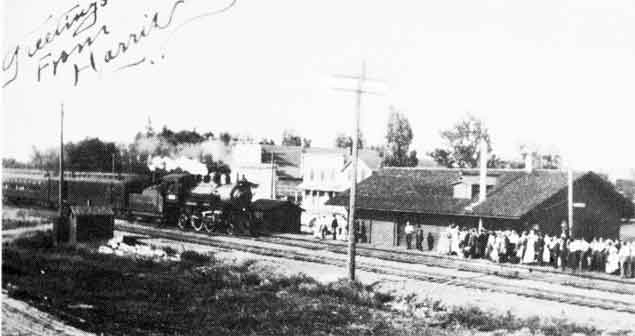
SUNDAY AFTERNOON IN HARRIS, CIRCA 1900: NOTHING TO DO BUT WATCH THE TRAIN COME IN I'm afraid we're all shiftless by comparison to these
progenitors. No
wonder they look so grim in the old photographs. Remember that they had
been practicing for this by moving all those rocks around in Sweden,
and I doubt that any one of them could have programmed a VCR. Since
nobody had TV, telling stories made for entertainment as good as any
sitcoms. In one of Elmer's stories, an immigrant in his old age tried
to drive a car. He had trouble steering and ended up running in circles
in a field, pulling back on the steering wheel, and hollering "Whoa!"
until the car ran into a stump and stopped. He knew rocks and horses,
but couldn't handle the Machine Age. Lucky for us the Age of Lugging
Rocks has evolved into the Information Age on the backs of those
impoverished immigrants. We descendants don't need to work that hard
anymore, which is why it is necessary for us to have all those
thousands of Mexicans lined up along the 8-foot wall between Tijuana
and California, waiting for dark so they can run (not walk) to work in
the Imperial, the San Joaquin, and the Sacramento valleys. It is
because of them, and their skill at field work, that fruit and
vegetables in the supermarket are ridiculously cheap compared to the
labor. Even if he would put up with the low wages, I don't know if
fitness workouts at the gym prepares an unemployed Silicon Valley
Software Whiz to earn his keep in the bean fields, let alone have the
stamina to walk home afterwards. John MacNamara was section boss in Hinckley at the time of the great fire, September 1, 1894. He had sent his wife and children to the depot to catch the train, but the depot caught fire, so they ran down the tracks to escape. She told the boys to run as fast as they could, and she would catch up. Two of her boys, aged 11 and 13, outran the fire, but Mrs. MacNamara and two other sons did not. Their bodies were found on the tracks later, along with a purse containing $3500 in certificates. Mrs. MacNamara and her two sons were buried in the Baptist Cemetery in Rush City. (This story came from Elmer Lofgren's recollections, as well as From the Ashes -- the Story of the Hinckley Fire of 1894, by Grace Stageborg Swenson, published by North Star Press, 1979.) |
